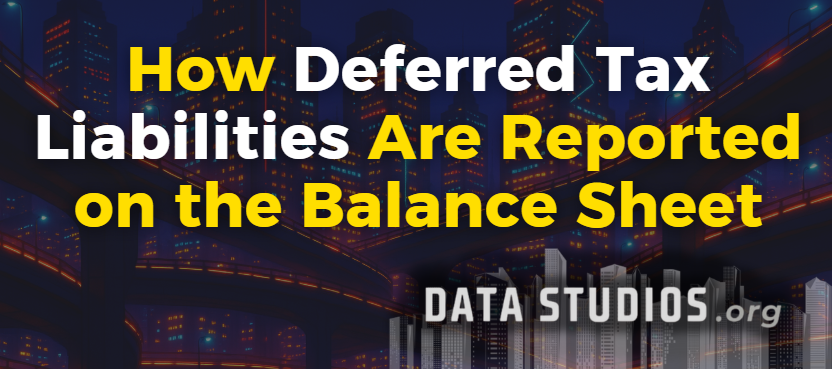How Deferred Tax Liabilities Are Reported on the Balance Sheet
- Graziano Stefanelli
- 14 hours ago
- 3 min read

Deferred tax liabilities represent future tax payments a company expects to make due to temporary differences between the carrying amount of assets and liabilities in the financial statements and their corresponding tax bases. These differences arise because accounting rules and tax laws recognize income and expenses at different times. Under IFRS (IAS 12) and US GAAP (ASC 740), deferred tax liabilities ensure that companies account for taxes consistently with how income is recognized, maintaining a clear link between accounting profit and taxable profit.
·····
.....
How deferred tax liabilities arise.
Deferred tax liabilities occur when income is recognized earlier in financial reporting than it is for tax purposes, or when expenses are deducted earlier for tax than for accounting. This timing difference temporarily reduces current tax expense but creates a future tax obligation.
Common examples include:
Accelerated depreciation for tax: tax law allows faster expense recognition than accounting depreciation.
Revenue recognized early in accounting: revenue may be recognized for reporting but not yet taxable.
Unrealized gains: fair value adjustments recorded in accounting but deferred for tax until realization.
Example:A company’s equipment has a carrying value of 800,000 and a tax base of 600,000 due to accelerated tax depreciation. At a 25 percent tax rate, the deferred tax liability equals 50,000 [(800,000 – 600,000) × 25%].
·····
.....
Presentation on the balance sheet.
Deferred tax liabilities are reported under non-current liabilities, since their settlement is expected to occur beyond one year. Companies often offset deferred tax assets and liabilities if they relate to the same tax authority and entity.
Example:
Liabilities | Amount (USD) |
Current Liabilities: | |
Accounts Payable | 180,000 |
Income Taxes Payable | 60,000 |
Non-Current Liabilities: | |
Deferred Tax Liabilities | 50,000 |
Lease Liabilities | 400,000 |
If a company also has deferred tax assets, netting is permitted under IFRS and US GAAP when legal rights of offset exist. The resulting balance may appear as “Net Deferred Tax Liability” or “Deferred Tax Asset (Net).”
·····
.....
Journal entries for deferred tax liabilities.
To record deferred tax liability at year-end:
Debit: Income Tax Expense 50,000
Credit: Deferred Tax Liability 50,000
To reverse in subsequent periods (when temporary difference unwinds):
Debit: Deferred Tax Liability 50,000
Credit: Income Tax Expense 50,000
This process aligns income tax expense in the income statement with the timing of reported profits rather than immediate tax payments.
·····
.....
Standards under IFRS and US GAAP.
IFRS (IAS 12 – Income Taxes): Requires recognition of deferred tax for all temporary differences except those arising from goodwill and certain initial recognition exceptions. Deferred taxes are measured using enacted or substantively enacted rates.
US GAAP (ASC 740 – Income Taxes): Uses similar principles but distinguishes temporary differences from permanent differences, and prohibits recognizing deferred tax on permanent items such as fines or tax-exempt income.
Both standards require remeasurement of deferred tax assets and liabilities when tax rates change, with the effect recognized in income or other comprehensive income depending on the related item.
·····
.....
Impact on financial performance and ratios.
Deferred tax liabilities affect both the income statement and the balance sheet:
Income tax expense increases in periods when new temporary differences arise.
Future income benefits when the liability reverses.
Effective tax rate (ETR) can fluctuate depending on the magnitude of temporary differences.
Leverage ratios (debt-to-equity) may appear higher because deferred tax liabilities increase total liabilities without an immediate cash impact.
Example:If tax depreciation exceeds accounting depreciation by 200,000 at a 25 percent rate, deferred tax liability of 50,000 is recognized. Over the asset’s life, this liability reverses as tax depreciation slows, equalizing the timing difference.
·····
.....
Disclosures required for deferred tax liabilities.
Companies must disclose:
The major components of deferred tax assets and liabilities.
The amount of deferred tax expense or benefit recognized in the period.
The nature of temporary differences that give rise to deferred taxes.
Unrecognized deferred tax liabilities on undistributed profits of subsidiaries.
The rate reconciliation between statutory and effective tax rates.
These disclosures help users evaluate tax strategy, timing of obligations, and sensitivity to future tax rate changes.
·····
.....
Operational considerations.
Deferred tax accounting links current performance with future tax effects. Management should regularly review deferred tax balances to ensure they reflect realistic future obligations. Changes in tax laws, asset valuations, or depreciation schedules can materially affect deferred tax positions.
For analysts, deferred tax liabilities indicate expected future outflows that don’t require immediate cash. Persistent growth in deferred tax balances may suggest reliance on tax deferrals or aggressive depreciation strategies. Proper understanding of these accounts supports more accurate assessment of long-term profitability and tax planning efficiency.
·····
.....
FOLLOW US FOR MORE.
DATA STUDIOS
.....[datastudios.org]




